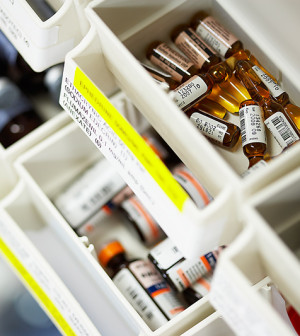- Navigating Your Midlife Crisis: Embracing New Possibilities
- City Raccoons Showing Signs of Domestication
- Mapping the Exposome: Science Broadens Focus to Environmental Disease Triggers
- One Week Less on Social Media Linked to Better Mental Health
- Your Brain Changes in Stages as You Age, Study Finds
- Some Suicide Victims Show No Typical Warning Signs, Study Finds
- ByHeart Formula Faces Lawsuits After Babies Sickened With Botulism
- Switch to Vegan Diet Could Cut Your Greenhouse Gas Emissions in Half
- Regular Bedtime Does Wonders for Blood Pressure
- Dining Alone Could Mean Worse Nutrition for Seniors
Are Fewer Cervical Cancer Screenings Needed After HPV Vaccine?

Women who’ve been vaccinated against human papillomavirus (HPV) likely need fewer cervical cancer screenings, a new study argues.
Just how often a woman needs a cervical cancer screening depends on the type of vaccine she had, the researchers said.
Women vaccinated with earlier versions of the HPV vaccine — which protect against the two worst cancer-causing strains of the sexually transmitted virus — only need cervical cancer screening every five years starting at age 25 or 30, the study concluded.
Women who’ve received the updated vaccine, which protects against seven cancer-causing strains of HPV, need screening even less often. The researchers recommend testing these women every 10 years starting at age 30 to 35 and ending at age 65.
Both screening regimens would be much less rigorous than current guidelines, which call for cervical cancer exams from age 21 every three years with a Pap test until age 30, then switching to a combination Pap test/HPV test every five years.
“Under no circumstances are the currently recommended strategies in any way preferred in these two groups of vaccinated women,” said lead researcher Jane Kim. She’s a professor of health decision science at Harvard T.H. Chan School of Public Health in Boston.
“I’m hoping this brings awareness to the policy makers that there needs to be a revision, hopefully to provide people with information among those with a good sense of what their vaccine status is, at least,” she said.
However, it’s unlikely that the American Cancer Society will revisit its cervical cancer screening recommendations in the near future, said Debbie Saslow, senior director of HPV-Related and Women’s Cancers for the ACS.
Too few women are getting the HPV vaccine, and the United States does a poor job of tracking vaccinations, Saslow said.
“We need to get vaccine rates up, we need to track them better, and we need to vaccinate on time,” Saslow said. “Then we can change our screening guidelines.”
HPV causes nearly all cases of cervical cancer. The early versions of the HPV vaccine are expected to prevent 70 percent of cervical cancer cases worldwide, while the newer version could prevent 90 percent of cases, the study authors said in background information.
The Harvard researchers developed a disease simulation model to estimate the risks and benefits of both the current and potential screening guidelines, taking into account the protection afforded by HPV vaccines.
They concluded that less-intensive screening is needed among HPV-vaccinated women because their risk of developing cervical cancer is quite low. Too much screening opens these women up to false positive results that require invasive follow-up tests. It also can lead to unnecessary health costs, the study authors noted.
“The current guidelines are not great for these lower-risk women,” Kim said.
The research team also concluded that doctors could do away with the Pap smear for HPV-vaccinated women, and screen them using just an HPV test.
These findings are “quite important,” said Dr. Jose Jeronimo, co-chair of the American Society of Clinical Oncology’s Cervical Cancer Secondary Prevention Expert Panel.
“It is expected that, in the future, the population of vaccinated women will have a much lower risk of cervical cancer, which would be translated into fewer life-time screening visits and potentially starting screening at older ages,” said Jeronimo. He is the senior advisor for women’s cancers at PATH, a Seattle-based global health nonprofit. “All these changes will represent significant saving of resources for countries.”
But, Saslow said the “devil is in the details” when it comes to cutting back on cervical cancer screening in the United States.
Far too few children are getting the HPV vaccine at this time, she said. “You have 56 percent of kids get the first shot, and maybe a third get all three,” she said. “You don’t know — did they get it at age 11, did they get it at age 18?”
In addition, there’s no national tracking system for vaccinations that allows either doctors or patients to know just which shots a person has received.
“If we had a health system and a set of health records so that a young woman walking into a provider’s office, her provider could see which of the vaccines she got at what age and how many doses, then we could personalize the recommendations,” Saslow said. “But we can’t do that in this country.”
More research is needed on the effectiveness of the HPV vaccine in preventing cervical cancer, Saslow said. Given that the HPV vaccine became available in 2006 according to the U.S. Centers for Disease Control and Prevention, not enough women have reached the age to start screening, much less to show the long-term effects of the vaccine yet.
“If somebody back then got the vaccine at 11 or 12, they’re just now at the age where we’re telling them to get screened,” she said, adding that revising the guidelines “probably won’t become an issue for us for five years.”
The new study appears in the Oct. 17 issue of the Journal of the National Cancer Institute.
More information
For more on cervical cancer prevention, visit the U.S. National Cancer Institute.
Source: HealthDay
Copyright © 2025 HealthDay. All rights reserved.










